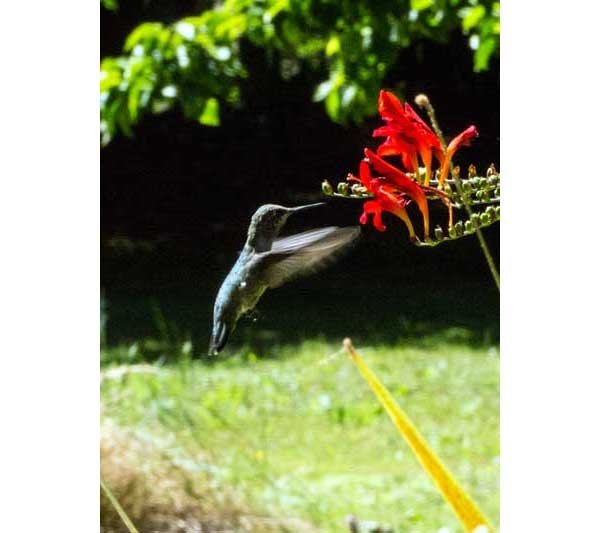 A female Anna's Hummingbird is captured feasting on the red flower of a crocosmia. Photo courtesy Joseph Pentheroudakis
A female Anna's Hummingbird is captured feasting on the red flower of a crocosmia. Photo courtesy Joseph Pentheroudakis
You're strolling along the Key Peninsula shoreline when you spot a little black bird with an orange beak bobbing on the water. Is it a Surf Scoter or a Common Scoter? Or is it a White-Winged Scoter?
Joseph Pentheroudakis could tell you.
He could also clarify the differences between a Common Goldeneye and a Barrow's Goldeneye, clear up confusion about Common Mergansers versus Hooded Mergansers, or delineate between Black-capped Chickadees and their smaller, less common cousin the Chestnut-backed Chickadee.
An avid birdwatcher since the 1970s, Pentheroudakis is starting a Key Peninsula birdwatching club for like-minded individuals, as well as those folks just getting interested in the hobby. Although the club, as of yet, exists only in virtual form, the 25 or so local folks signed up on his Facebook page are eager to hold their first meeting and start identifying birds.
Pentheroudakis is a Seattle-based artist who also owns a home on Herron Island.
Originally the island home was only meant to be a weekend respite from the hectic urban life, but after spending a month out here a few summers ago, that changed. Pentheroudakis, who also loves to cycle on the KP, says, “Once I got in the natural quiet rhythm of being on the island I was hooked.” Now he splits his time between homes, making it out to the Key as often as possible to enjoy the natural environment.
What keeps Pentheroudakis interested in birding is the beauty of the birds, as well as their delightful sounds.
He sees birding as a scientific venture as well. Much as canaries once foretold of poor air quality in coal mines, to those in the know, tracking bird populations and migration patterns can provide a lot of clues about the health of our planet, he said.
“Birds are an important component of our natural environment, so observing them is a great way to become aware of the diversity and fragility of that environment,” Pentheroudakis said. “Bird movements are clearly related to climate, environment, and habitat changes, so bird activity provides indirect evidence for that. For example, crows have moved into cities in huge numbers in recent decades to a great extent because of the loss of rural habitat,” he added.
Pentheroudakis keeps records of some of the birds he sees and reports his numbers to centralized organizations during the National Audubon Society's Christmas Bird Count, as well as the Great Backyard Bird Count every February.
In addition, watching a Kingfisher recently smash its freshly-caught fish dinner against a tree limb made for entertaining outing.
Key Pen Parks Commissioner Bill Trandum is a friend of Pentheroudakis and also a birdwatcher. Trandum is partial to the speed-demon acrobatics of a sandpiper called the Dunlin.
“It's a shoreline wader that breeds in the arctic during the summer, then winters here. Dunlins fly in close order formation and put on spectacular and intricate air shows, reaching speeds as high as 110 miles per hour,” Trandum said.
Trandum believes bird watching is a hobby of interest to all ages.
“My other particular joy is feeding seagulls with my grandkids. When the kids visit, if the tide is high, we take leftover bits of pancakes and waffles to a deck near the water. The kids then try their best to make seagull sounds. Often 30 or 40 gulls answer the call so the kids toss tidbits to the noisy scrambling flock,” he said.
According to Pentheroudakis, bird watching is an accessible hobby requiring only an identification guide and a good pair of binoculars. Before shopping, he suggests becoming familiar with the two numbers used to describe binoculars. One number gives their magnification and the other tells the size of the lenses.
A sense of adventure helps too, he says. “We one time counted seven mature Bald Eagles perched in our nearest neighbor's old maple tree. We believe they were feeding on anchovies trapped on the tide flats by a receding tide,” he said.
If you are interested in joining the new Key Peninsula Birding club, contact Pentheroudakis at facebook.com/groups/KeyPeninsulaBirding/.
UNDERWRITTEN BY THE FUND FOR NONPROFIT NEWS (NEWSMATCH) AT THE MIAMI FOUNDATION, THE ANGEL GUILD, ADVERTISERS, DONORS AND PEOPLE WHO SUPPORT INDEPENDENT, NONPROFIT LOCAL NEWS